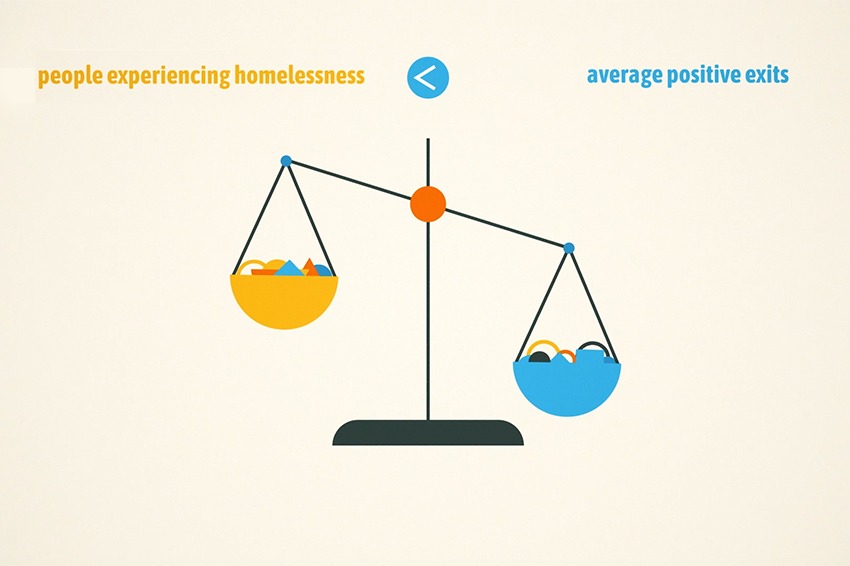Ending homelessness is not a finish line. It is a reality that must be sustained.
At Community Solutions, we celebrate the moment a community achieves functional zero — the milestone where communities have proven that they have measurably and equitably ended homelessness for a population.
Getting to that moment is tremendously difficult. It is often the result of immense dedication from countless people. It can take months, or even years. Acknowledging the momentous achievement is important for honoring that work and proof of what is possible.
But leaders themselves will tell you that ending homelessness is not about a single moment of achievement. The work of sustaining an end to homelessness continues.
Amanda Harris has helped lead work to end homelessness in Montgomery County, Maryland. Her community reached functional zero for veteran homelessness in December 2015.
“Sustaining functional zero is about our credibility of ending homelessness in the community and for the populations we serve,” she said. “It’s not enough to have achieved it on one day, to check a box and forget about it. It’s important we’re able to keep our foot on the pedal.”
View video transcript
Can you imagine what solving homelessness would look like in your community? How would you know if your city was making or sustaining progress?
Solving homelessness is complex and only possible if everyone is working together toward a shared reality. That is why defining the goal and how to measure it is the first step. But getting clear on what it looks like to end homelessness is also a challenge. People, politicians, and practitioners define it differently every day.
Ending homelessness isn’t about making the problem less visible. It isn’t a one-time achievement. It isn’t an aspirational but unachievable feat.
It is the hard work of creating a new reality. A more equitable one where homelessness remains rare and brief.
Across the country, communities in the Built for Zero movement are solving homelessness for specific populations, with the aim of ending it for all people. They use functional zero as a measure of whether they are achieving these goals.
There are four important components of what it means to achieve functional zero.
Functional zero means homelessness across a population is rare, and measurably so. In this state, fewer people are experiencing homelessness than are routinely accessing safe and stable permanent housing in a month.
In other words, the number of people experiencing homelessness at any given time is never exceeding the community’s capacity to ensure positive exits.
Functional zero also means cities and counties are operating off of a full accounting of homelessness at all times, by maintaining quality, real-time, comprehensive data on who is experiencing it.
By achieving this milestone, the community is working toward equitable systems, starting with a focus on race and ethnicity. Any system that is not designed to identify and respond to disparities risks perpetuating them.
Finally, all of these achievements are sustained over time, even as local conditions change. Communities reach functional zero once, and they must keep reaching it, over and over again, as they work toward an end to homelessness for all.
Countless forces, like an economic crisis, a natural disaster, or a pandemic, can increase the likelihood of housing crises. But by achieving functional zero, communities are developing resilient systems that consistently respond and reduce homelessness toward zero.
Achieving functional zero is a critical step toward an equitable future where homelessness is never inevitable, inescapable, or a way of life.
#HomelessnessIsSolvable
Learn more at BuiltforZero.org
Functional zero as a dynamic measure over time
Countless forces, like an economic crisis, a natural disaster, or a pandemic, can increase the likelihood of housing crises. In a heightened way, consequences of the COVID-19 pandemic — like the lifting of eviction moratoriums — are continuing to highlight how external forces can increase the risk of housing instability or homelessness across populations. The dynamic nature of homelessness is precisely why we use functional zero as a definition for ending homelessness.
Among other things, functional zero defines success by looking at how many people are experiencing homelessness at any given time. This means that the number of people within that population consistently remains under a measurable threshold that represents the system’s monthly capacity to support positive exits from homelessness.

By achieving functional zero, communities are developing resilient systems that consistently respond and reduce homelessness toward zero. This requires a system that can continuously identify and support people experiencing homelessness, to ensure homelessness remains rare and brief across that population.
Sustaining an end to homelessness
Once communities reach functional zero, they typically initiate two important lanes of work: sustaining an end to homelessness for the initial population and working to end homelessness for another population.
“The goal is a truer measure of a system that is resilient and has the capability to absorb shocks and sustain an end to homelessness,” said Aras Jizan, Portfolio Lead for Data and Technology for Built for Zero.
Abilene, Texas, first reached functional zero in November 2018 for veteran homelessness. As they sustained an end to veteran homelessness, the community ended chronic homelessness in January 2020.
“It’s wonderful to get to that point,” said John Meier, program manager at the West Central Texas Regional Foundation. “But it doesn’t mean you stop doing what you’re doing. You continue pushing through.”
Since achieving these milestones Abilene has sustained functional zero for both populations while working to end homelessness for youth and families.
The work of sustaining is not easy. It requires constantly adapting to the changing dynamics of homelessness in a community, like tackling inflow so people can avoid becoming homeless in the first place.
Jennifer Jones helped her community of Fremont County, Colorado, reach functional zero for veteran homelessness in February 2021.
“It was a milestone getting to functional zero,” she said. “But it’s the work after the fact that’s been harder.”
On the day that the community announced achieving functional zero, they identified three new veterans experiencing homelessness. Today, they have driven that number down to one veteran, back below their functional zero threshold of three veterans.
“However hard it is, the great thing is that the lessons we are learning with sustaining functional zero is helping us make progress on other populations,” Jones said.

“It’s not about meeting a milestone for a day or a period. It’s about sustainability.”
— Jennifer Jones, Fremont County, Colorado
Assessing and providing support for communities in sustaining
Since Built for Zero launched, the initiative has monitored the number of communities that have reached functional zero, and are sustaining.
With support from the MacArthur Foundation’s 100&Change grant, our organization is further focusing on how to understand the barriers to sustaining functional zero and improving our support to communities in addressing these challenges. As an organization, we are committed to doing everything possible to support communities sustaining these functional zero outcomes over time.
“We recognize that community leaders working to sustain functional zero are the vanguard of a national movement to end homelessness,” said Nate French, Portfolio Lead for Built for Zero. “Our hope is to get behind the work and vision of these important leaders to support this sustaining work over time and, together, discover and demonstrate what this looks like for others following in their footsteps.”
This will include having regular check points with communities focused on sustaining, and using those moments to understand how we can deploy the right support at the right time. We will also conduct an annual review of community data to confirm communities that are meeting the sustaining standard and those that are not, and updating our communications accordingly.
The list that emerges from the annual review will confirm that a community:
- is reporting data is complete and meets quality standards
- has demonstrated an ability to sustain for a minimum threshold of time throughout the year, and
- can demonstrate commitment and progress on racial equity indicators.
Sustaining as the end goal
Communities are proving it is possible not to just achieve functional zero once, but to sustain it over time. To date, 14 communities in Built for Zero have achieved and sustained functional zero for a population.
“It’s not about meeting a milestone for a day or a period,” Jones said. “It’s about sustainability. It’s about making sure the system is still working and in place, like a well-oiled machine.”





